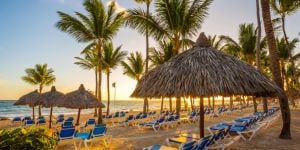Solar panel orientation
Subscribe to the topic
Post new topic
Has anyone here had a technical survey done on what direction solar panels can/should be placed on a roof? We have a steeper angle roof than most....we are going to add 6 more panels but are out of space on South facing side...but I imaging at 19° north it's different than 45° north...husband wants to place them on east facing side ... Would love to hear other's opinions/experiences...
I still think we need a new category for 'building'...
Remember to consider the mounting angle....
should be 23 degrees or so at this latitude
Have you spoken to Richard at Grec
http://www.grec-energy.com/
He's the Go-To guy in Cabrera
Yes. I've asked Richard... he's been helpful...our roof is pretty steep...so, for example right now...the south facing panels are getting very little direct light...compared to winter...we are debating solar panels on two sides to capture sun at different times of day/season...but I haven't seen any houses with panels on two sides...summer is the only time of year, I need AC!
Side note: Will, are you friends with Keith and Paula? I think they mention you all the time, but we haven't met...
I asked.my two contacts with experience in this. Their answers: it depends! So depends on house, angles, etc etc. Not overly helpful to you.
Mount them on the ground - not the house to maximize their efficiency
Is my suggestion
Nope- don't know a Keith or Paula.
I have 22 panels installed on the North side of my roof and a solar hot water heater also installed on the north side of my garage roof. I achieve high efficiency pretty much all year around except when we have very cloudy periods. Our electric company gave me my first cheque in January for providing the grid with more energy than I consumed.
My advise is to NOT install on the ground for the reasons of not being able to control the surroundings. Trees grow, walls are erected, buildings are erected all of which may block or shadow the sun from your panels. Also easier to damage the panels on the ground. Only my opinion.
And as I have said before Planner, in the DR it always depends...lol
I am like you but my roof was built for the installation....
they are tilted racks up there - invisible
I only say the ground b/c it seems the roof lines aren't hospitable
P.S. don't worry about the roof angle. You can always mount your panels on an adjustable or fixed rack to compensate for the angle. A little more money but cheaper than a new roof or house...
FYI it's my understanding only private electricity companies will cut a check when you feed the grid. The EDE's will not. Any confirmation on this?
Canada Mike
I read the post as saying that they were having to change sides /orientation on the roof
No more room on one slope
I would not start fiddling w/ that... I would build a platform for them in a sunny area
Mine are on racks....
36 gel batteries powered by 15 190W Sanyo panels
after 10/11 yrs... still going strong
Well, i haven't installed any solar panels yet...but I've come close 3 times.
HOUSE- vs. GROUND- mounted, at least here in Idaho, relies on three factors:
>> Do you own a lot large enough to mount the panels on the ground? If you have a small lot, you need to do it on your roof. Case closed
>> Does your home/roofline have sufficient southern exposure to accommodate your desired solar installation? If not, must do ground mount.
>>> Is your roof pitch steep enough to allow your solar panels TO SHED SNOW (remember, this is Idaho) without too much intervention (long roof rake or getting on roof yourself to shovel it off)? Given our lattitude, relative pitch of solar cells is pretty steep compared to, say, the Caribbean.
If your panels are covered with snow, they deliver ZERO watts!!
I've met several owners of roof-mounted panels that wished they had done ground-mounted installs -- solely because of snow removal difficulties. More can be found on YouTube.
I've not met any ground-mount owners that wished they had done a roof install -- at least in Idaho.
So...what about the DR?
You ain't got no snow...so ground mounting provides minimal advantages.
Roof mounting in the Caribe, though, also shades your roof which saves cooling costs. You need appropriate air space between panels and roof to avoid superheating bleed, but this is manageable.
-- you need your panels tilted a bit from vertical, just to help shed rain water to prevent pooling. Again, manageable.
Bottom line: I think in the Caribbean, the ground vs roof mount comes down to aesthetics.
>> A steep roof will require BIG lower mounts to get the right tilt to maximize solar angle.
-- That would probably be pretty ugly.
-- In that sole case, in the Caribbean, I might prefer a ground mount install.
And that's the view from Idaho.
Jim
ExpatRusher
For the OP's question:
You probably don't need an expensive survey to determine your optimum panel pitch angle.
Plenty of inexpensive books explain how to do the calculations
One such is http://www.solarelectricityhandbook.com … ator.html.
You may also find calculators online.
BUT, a site survey should also address/identify thse issues, just as a start:
>> power distribution challenges and optimum positioning.
>> Shade issues (trees that shade your panels today...or in future with growth).
>> Certify your specific roof's structural soundness for a solar installation. (Not usually an issue in well-developed nations with strong building codes; but definitely a question in countries with no or weak building codes.)
Jim
This is the little tool I use. Shows you yearly insolation and takes into account shadows, etc.
https://www.solarpathfinder.com/index
i built a house in peurto plata last year and had jean Abbott , JA solutions?809-796-5444 install 10kw .
What I liked was that they used all aluminum frame work with stainless steel bolts.
its connected to an inverter that connects to puerto plata electric. I virtually have no electric bill each month. And I have allot of A/C units 2 fridges 2 pool pumps etc.
I priced it around and prices were mixed.
As I remember..... 22-23-24 degrees is the angle
Being as far south as we are here, little need to realign them during the year
Mine are fix mounted on my roof- on racks
SO here is a discussion on Solar that I hope this fits. I'm looking into for house which for which construction will soon start. Can anyone tell me what the cost of panels and wattage. I noted Willie said 190 watt but those are rather old. As it happens, I have a solar company here in Red Deer AB that does solar installation all over and did one for an NGO organization in Haiti not to long ago. They use 400 watt panels and sell them for $251 plus tax - $263.55 Cdn and will ship to me. I'm looking for info on batteries there for solar storage. In Moca, if I recall correctly, I've seen them new in Jumbo for $22,000 DOP. I want soar charged battery bank backup/use for continuous power in workshop house and guest tiny house. Tried contacting a solar company in Santiago last year but they never replied back. My guest tiny house (400 sq ft) will only have solar and battery power and I hope my workshop will be that way as well - power to run lights in tool shop, board planer - the largest one power drain item, and assorted power tools. Only seem the odd solar panel in front of some stores but didn't get to see wattage....cheers
i posted the company that did mine. call jean abbott 809-796-5444
i did 10 kw cost was around 10k for complete job. i m hooked up to the grid, so I sell the electric i don't use during the day to porto plata electric and buy back what i need at night. i have a close to zero electric bill each month. I'm considering adding a bank of 16 batteries with a smart switch . that's enough back up to continue what im doing but not need to buy back at night. i can run 220 air-conditioning then off the batteries. during the day the batteries get charged fully before selling the electric.
We are using EVR Solar in Las Terrenas. We were told 10 degrees was sufficient for our north facing panels.
@brodies2013
hi!
we are also installing north facing panels.
how has this worked out for you over the last few years? Any suggestions?
We are using EVR Solar in Las Terrenas. We were told 10 degrees was sufficient for our north facing panels.
-@ddmcghee
I’m not sure if it was a change or I was mistaken above, but when installed earlier this year, our panels all are slanted to the south on our flat roof.
I have North facing panels that work very well. I generate double the energy that I consume... The electric company pay a small amount for the additional energy they receive from me.
@brodies2013
I have read all theses posts, and one thing that was not mentioned is the integrity of your roof after the panels are installed. The reason being if there is a hurricane your roof could be severely compromised. Just something to think about. The panels should also be pointed to the equator if possible for maximum exposure.
I have a 1-foot-thick concrete heavily steel re-enforced roof...I think there is no compromising here...
@DominicanadaMike wow wow...is that a nuclear bunker ?
Curious what is a normal concrete slab roof depth? Your is 1 foot what is the normal here or a range here?
I'm not a builder but I believe my house is an exception. Of course it will depend upon the size of the roof and the amount of supporting walls etc. I am sure you will find 4 inches to be more average. Just my opinion...
Hello @Mikael Desilus,
Hope you're well.
Unfortunately @GuestPoster38 is no more available on expat.com
Have a nice day,
Mickael
Expat.com - Team
@planner
I have an 8 inch roof w/ rebar 6 inches on center on top of a two story house that measure around 3000 - 3500 sq footage but both my neighbors have a 4 -5 inch slab roof on a 1500- 1800 square foot on a one story
All the houses were built around the very early 60’s maybe late 50’s ….. till this day I don’t think there’s any building codes they went by except the teachings that were passed down from Generation to generation ( tested and tried ) maybe today they try to follow some kind of guidelines for insurance purposes but before the 70’s & 80’s housing booms I bet it was the Wild West with the Attitude I can build better then you Mentality
@planner I think a foot is about normal in DR. I just finished a Nave (warehouse) and decided to not use that zinc roof they put on warehouses out there and it was a foot also with the rebar reinforcement. If anyone is curious it was about $100,000 pesos per truck load on pouring the cement. I thought that was a great price for all the cement I needed!
Articles to help you in your expat project in Dominican Republic
 Working in the Dominican Republic
Working in the Dominican RepublicIf you are looking for a job in the Dominican Republic (DR), here are some tips and suggestions. Job hunting can ...
 Dating in the Dominican Republic
Dating in the Dominican RepublicJust like anywhere else in the world, people in the Dominican Republic want to find love, their significant other, ...
 Education in the Dominican Republic
Education in the Dominican RepublicThis article will cover the Dominican Republic's educational system, including public schools attended by 80% ...
 Driving in the Dominican Republic
Driving in the Dominican RepublicWhat is driving like in the Dominican Republic and how do you obtain a driving license? Find out all about it in ...
 Setting up a business in the Dominican Republic
Setting up a business in the Dominican RepublicThe Dominican Republic has indeed been attracting foreign investment over the past few decades, with notable ...
 The healthcare system in the Dominican Republic
The healthcare system in the Dominican RepublicIf you are moving to the Dominican Republic, one of your primary concerns is likely to be the healthcare system ...
 Death in the Dominican Republic
Death in the Dominican RepublicWhat customs and procedures are common when dealing with death in the Dominican Republic? Find more about it in ...
 Divorce in the Dominican Republic
Divorce in the Dominican RepublicThe Dominican Republic offers a number of types of divorce, the most common of which are divorce by mutual consent ...
Find more topics on the Dominican Republic forum



